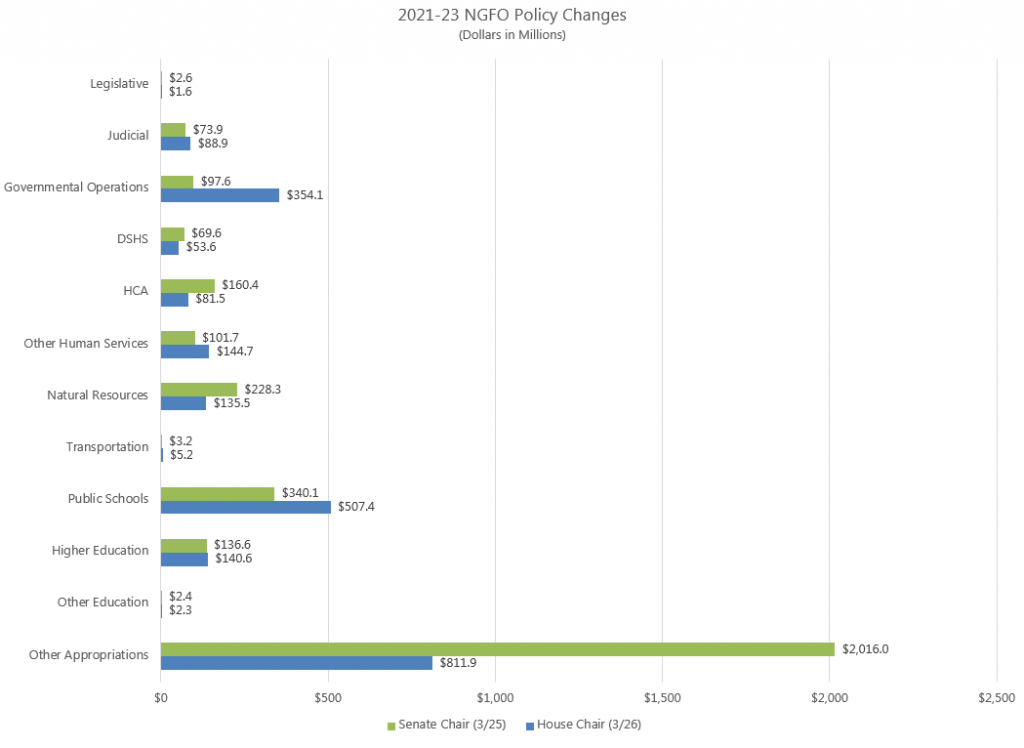3:09 pm
March 30, 2021
For 2021–23, the proposals from the Ways & Means and Appropriations Committee chairs assume that the maintenance level (the cost of continuing current services, adjusted for inflation and enrollment) for funds subject to the outlook (NGFO) is $55.983 billion. (The Ways & Means and Appropriations committees amended and passed their chairs’ budget proposals yesterday, but revised numbers are not yet available. The numbers in this post are based on the chairs’ original proposals.)
The House Appropriations chair would increase policy level NGFO spending by $2.327 billion and the Senate W&M chair would increase policy level NGFO spending by $3.233 billion. The first chart shows how the NGFO policy changes are distributed across budget areas.

Major NGFO differences include:
- In governmental operations, both House and Senate chairs would fund the working families tax credit, but they account for the funding differently. The House chair would appropriate $142.2 million from the NGFO (plus $126.0 million from the taxpayer fairness account). The Senate would appropriate the full amount from the taxpayer fairness account, after transferring $142.2 million from the general fund–state to the taxpayer fairness account.
- In natural resources, the Senate chair would appropriate $125.0 million for forest health and the House chair would appropriate $5.4 million. The House would appropriate $84.0 million for the farmers to families food box program.
- In public schools, the House chair would fund five additional school days ($278.1 million) and remove the Running Start enrollment limit ($35.2 million). Both would add counselors for high poverty schools ($52.5 million in the House and $32.8 million in the Senate). The Senate would appropriate $190.7 million for school funding stabilization and $59.0 million for transportation emergency funding.
- In other appropriations, both would fund foundational public health ($100.0 million in the House and $150.0 million in the Senate). The House would provide one-time funding for cities ($58.0 million) and counties ($86.0 million) “for the costs of new or increased services as a result of legislation enacted between January 1, 2020 and June 30, 2021.” The House would appropriate $125.0 million for a new wildfire response, forest restoration, and community resilience account. The Senate would appropriate $100.0 million to the new health care affordability account, $73.3 million to the disaster response account, and $60.7 million to the environmental mitigation account. Additionally, the Senate would appropriate $800.0 million for the Teachers’ Retirement System Plan 1 fund to reduce its unfunded actuarial accrued liability. The Senate would appropriate $500.0 million to the new unemployment insurance relief account. (Note that the House would appropriate $600.0 million for unemployment insurance tax relief, but the funding would come from state’s share of the federal coronavirus state fiscal recovery fund.)
New policies in the House chair’s proposal would increase appropriations from all budgeted funds by $17.095 billion, compared to $15.279 billion in the Senate chair’s proposals. The chart below shows the policy changes from all funds by budget area.

Major differences outside of the NGFO (including federal COVID relief funding) include:
- In governmental operations, the House chair would appropriate $250.0 million for business assistance and $138.0 million for the small business credit initiative. Both proposals would shift $230.0 million in expenditure authority to 2021–23 from FY 2021 for rental assistance. The House chair would add $1.070 billion for rental assistance (compared to the Senate’s $255.0 million) and $121.6 million for housing/homelessness assistance.
- In other human services, the House chair would appropriate $1.185 billion for COVID public health (from the ARP Act) and the Senate chair would appropriate $1.538 billion. The $600.0 million the House chair would appropriate for UI tax relief is accounted for here.
- In other appropriations, both proposals would spend $900.0 million on testing and contact tracing. For the public health workforce, the Senate chair would appropriate $100.0 million and the House chair would appropriate $145.0 million. For vaccines, the Senate chair would appropriate $100.0 million and the House chair would appropriate $140.0 million.
Previous posts on the proposals are here, here, here, and here.
Categories: Budget.Tags: 2021-23
